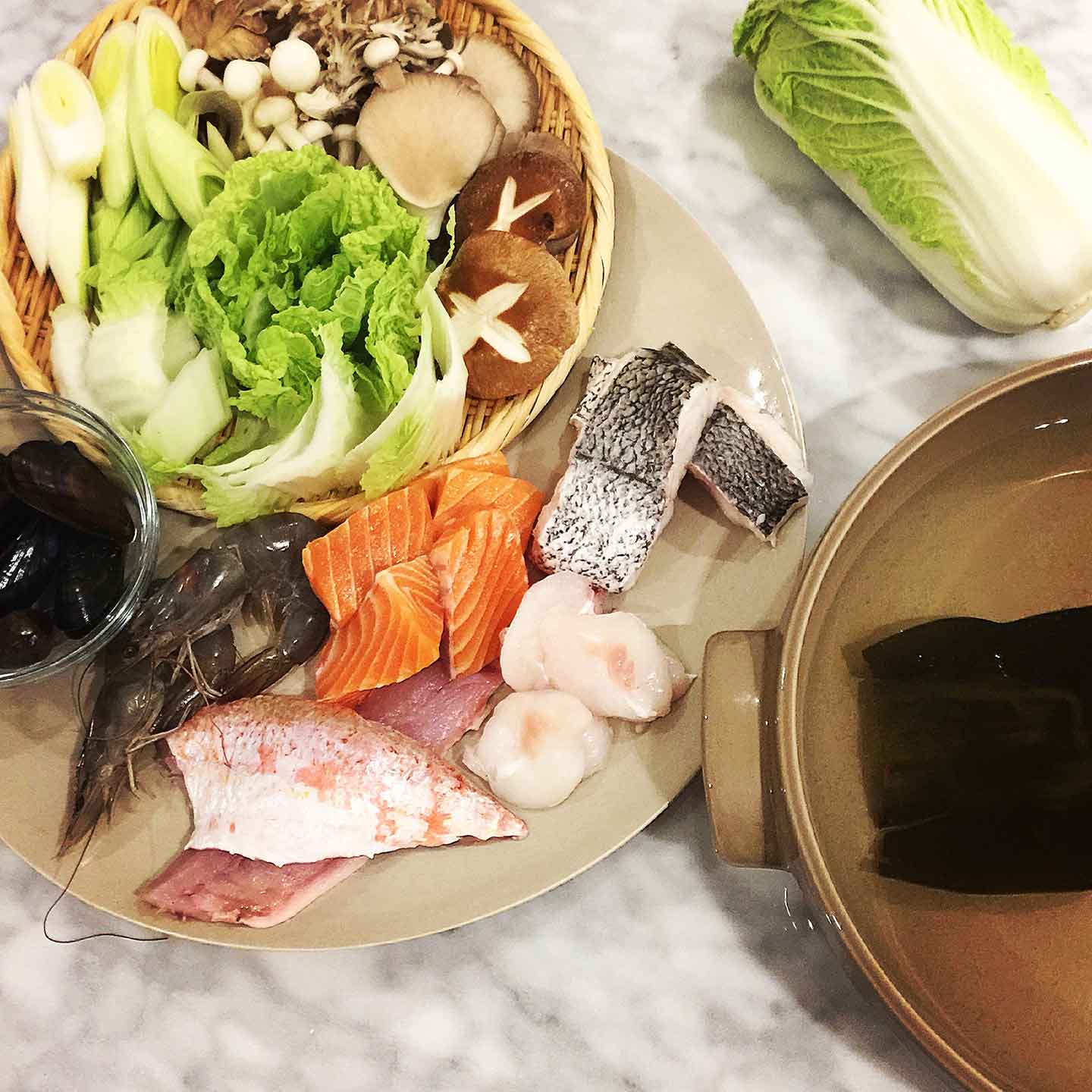Okay, so Spring is definitely well on its way now! However, today there is a cold wind blowing and there are still some frosty mornings. So here is a recipe to enjoy for dinner, a warming Japanese hot pot, Seafood Nabe. Nabe or Nabemono is cooked and served at the table. It is a clever way of eating, as it means you can eat at much as your appetite allows. For dinner parties, it is an efficient choice as your guests will be doing the cooking!
Due to the mix of ingredients, Nabe has great nutritional value. This might be just the trick to get rid of that lingering cold or flu. In the winter months in Japan, everyone talks about Nabe as a comfort dish, perhaps like a beef or lamb stew here in the UK. It is a Japanese style hot pot full of exciting, humble flavours from the core ingredients in season; fish, chicken or pork and seasonal vegetables such as leeks, mushrooms and Nappa (Japanese cabbage). With an umami depth from the Kombu stock, it will leave you wanting more. I think my Mother loves to cook it as it helps out with the next day’s dish. You can use the remaining broth for a noodle dish or rice dish like risotto. So if you’re looking for an easy to digest light dish that packing in nutrition, and keeps your warm, I would highly recommend Nabe.
The basis for the Nabe, is Dashi (Japanese stock), which is the basis of many Japanese dishes, such as soup, dipping sauce, and slow cooked dishes “Nimono”. There are many varieties of dashi, some of my favourites are:
- Kombu dashi stock is made by soaking kelp, or sea tangle, in water.
- Niboshi dashi stock is made by pinching the heads and insides off small dried sardines, to prevent bitterness, and soaking the remains in water.
- Katsuo dashi stock is made from dried bonito flakes, scattered into hot water.
- Shitake mushroom dashi stock is made by soaking dried shitake mushrooms in water.
Here is the super easy recipe, it is all about choosing the best, freshest ingredients (as always!). Once you have prepared the dipping sauce and dashi, you are good to go!

Seafood Nabe with Home-made Ponzu Dipping Sauce
Serves 4
Ingredients & Kit
Portable cooker (great if you do have one, as cooking at the table is the best way to enjoy this)
Seafood and/or fish
Red Mullet, turbot , sea breams, salmon, cod, cod cheeks, scallops, prawns, clams, mussels (choose whatever is fresh and in season)
Vegetables:
Leeks, Nappa cabbage, Shitake mushroom, shimeji mushrooms, oyster mushrooms, Enoki mushrooms (again, there are no rules, choose fresh, seasonal ingredients)
Kombu Dashi
Kombu Dashi (Makes 600ml)
Kombu (dried kelp) 1 piece of about 240mms ×50mms
Water 600ml
Ponzu Dipping Sauce
100ml Tamari soy sauce
100ml Lime juice
2 tbs Mirin
3cm x 3cm piece of dried Kombu
A handful of Katsuobushi (bonito flakes)
Method
Remember to make the ponzu sauce a day before you need it. Mix all the ingredients together in a small bowl and keep it in the fridge for 24 hours to rest. Strain the sauce through a fine sieve into a container or bottle. You can keep the ponzu sauce in the fridge for a few weeks. When it gets cloudy and loses its shine, it’s time to throw it out.
Use a shallow pot to make the stock. Firstly, wipe the Kombu with a clean cloth. (the Kombu shouldn’t be washed.)
Put the water into the pot and soak the Kombu for about 30 minutes.
Heat it up slowly and as the water comes to a boil, take out the Kombu and remove the stock from the heat.
Pour the ponzu into small bowls, one per person.
Using the portable cooker on the dining table or if you do not have one, you can cook on the kitchen hob.
Gradually add small quantities of the fish, seafood or vegetables, to cook each. No need to add them all at once, the meal is all about pacing the enjoyment!
When they are cooked, pick them out and dip with ponzu sauce.
At the end of the meal do keep the stock. Later or the next day, you can make a delicious noodle or rice porridge. Simply use the broth to cook udon noodles or Japanese rice. This is actually one of my favourite dishes as it packs even more flavour than the Nabe! The deep taste comes from the mushrooms and seafood, or fish cooked in the dashi.
Enjoy the meal and keep warm in these last few days of the cold!